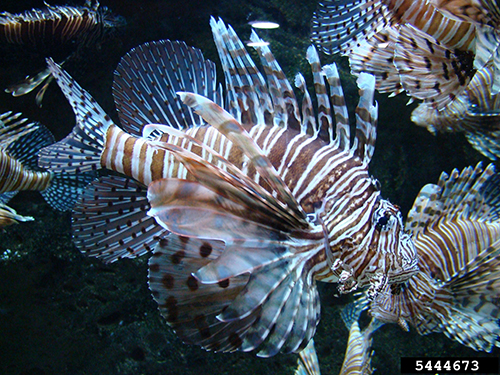Lionfish
(Pterois volitans & P. miles)
Origin:
Indian & Pacific Oceans
Introduction to Florida:
Aquarium releases (intentional or accidental)
Stage on Invasion Curve:
Long-term management


Description
Lionfish are primarily red, brown, and white with a striped, zebra-like appearance. They usually grow to about 12–15 inches long, but sometimes grow to more than 18 inches long in areas where they are not native. Lionfish have 18 venomous spines that are used defensively against predators. Two short venomous spines are located on the pelvic fins (one on each side). Three additional venomous spines are located along the front edge of the anal fin. The large and featherlike pectoral fins and the tail fin do not contain venomous spines. There are two closely related species of lionfish in Florida: the red lionfish (Pterois volitans) and less common devil firefish (Pterois miles).
Impacts
Lionfish can eat prey that are more than half their own length and are known to eat more than 70 marine fish and invertebrate species including yellowtail snapper, Nassau grouper, parrotfish, banded coral shrimp, and cleaner species. They also compete for food with native predatory fish such as grouper and snapper. They may negatively impact the reef habitat by eliminating organisms that serve important ecological roles, such as herbivorous fish that keep algae in check. Adult lionfish spread their pectoral fins and use them to “herd” prey and then often corral them into a corner. They are the only species known to blow water at prey in an effort to get prey to turn toward the lionfish before being devoured.
Where to Find Them
Lionfish populations are found in coastal waters throughout the Caribbean, Atlantic, and Gulf of Mexico. They live in many marine habitats including natural and artificial reefs, hardbottom, seagrass beds, mangroves, and estuaries. They can be found in depths ranging from 2 to 1,000 feet. They can survive temperatures as low as 52°F and very low salinities.
Distribution Maps
What You Can Do
- If you are a diver or spearfisher:
- Remove any lionfish you see using a pole spear or handheld net.
- Report the location of your lionfish to MyFWC.com/Lionfish or by using the Reprt Florida Lionfish smart phone app.
- Become a Reef Ranger!
- If you are not a diver or spearfisher:
- Request lionfish at your local seafood market or restaurant.
- Teach others about invasive lionfish and encourage them to get involved.






